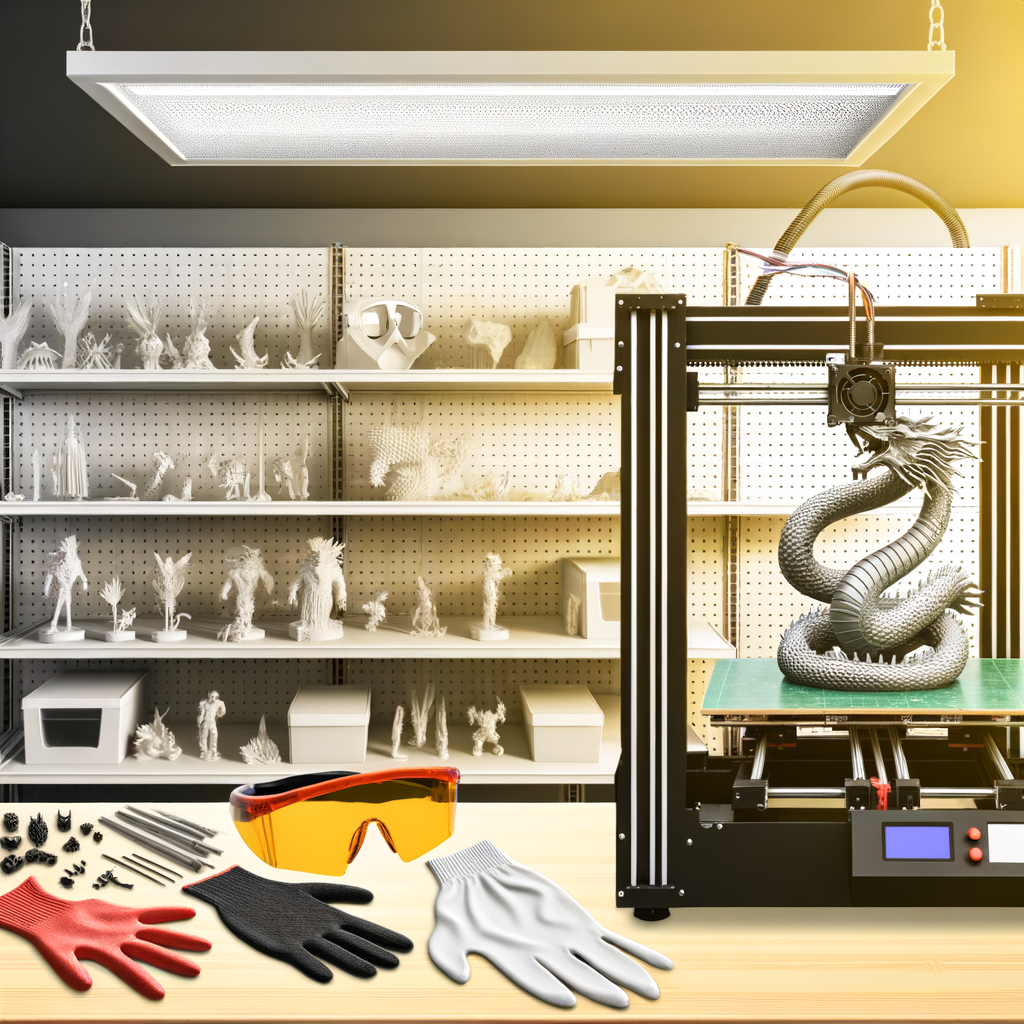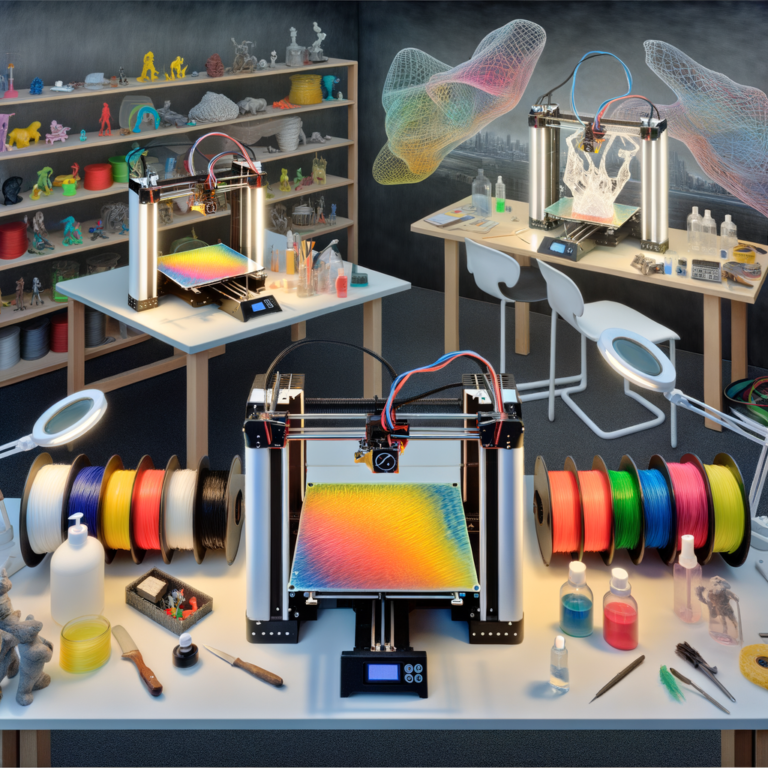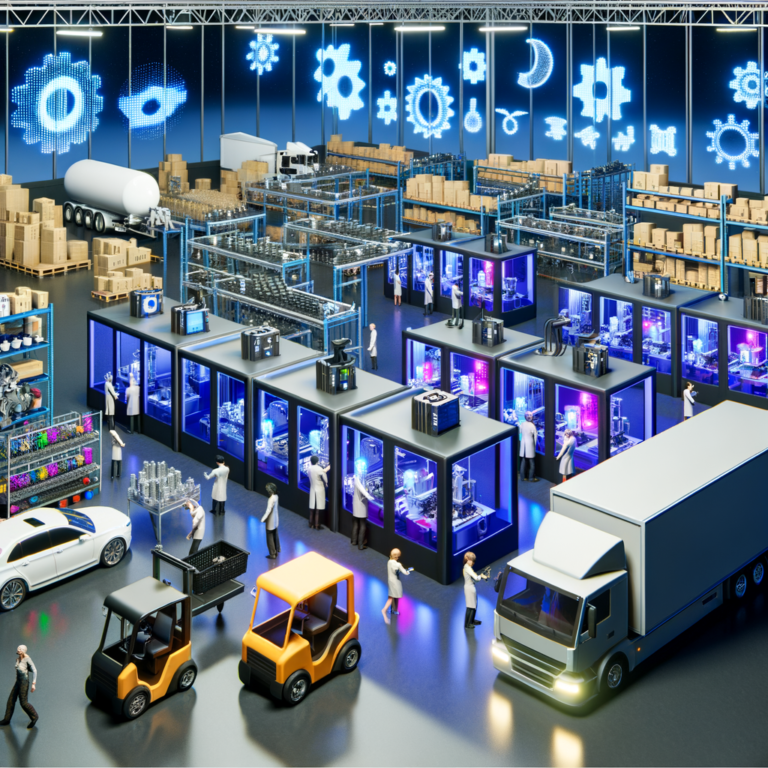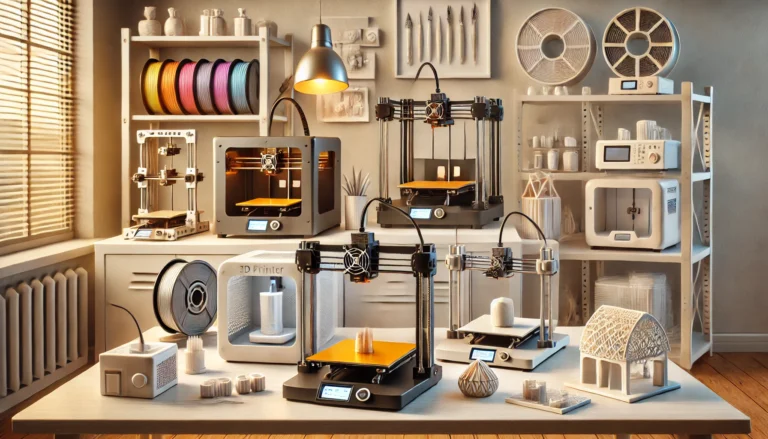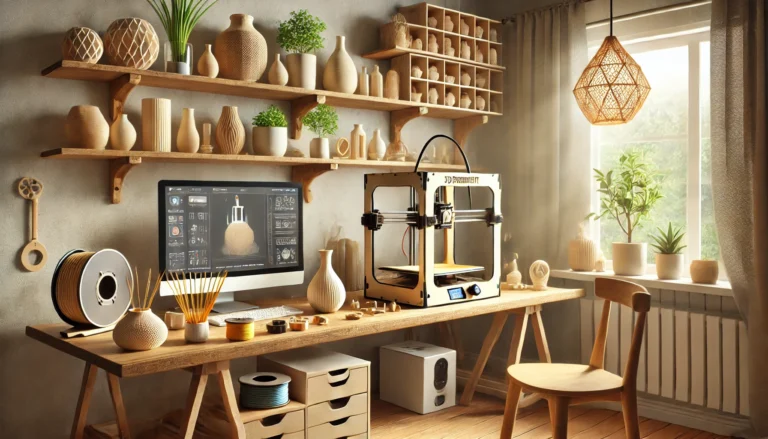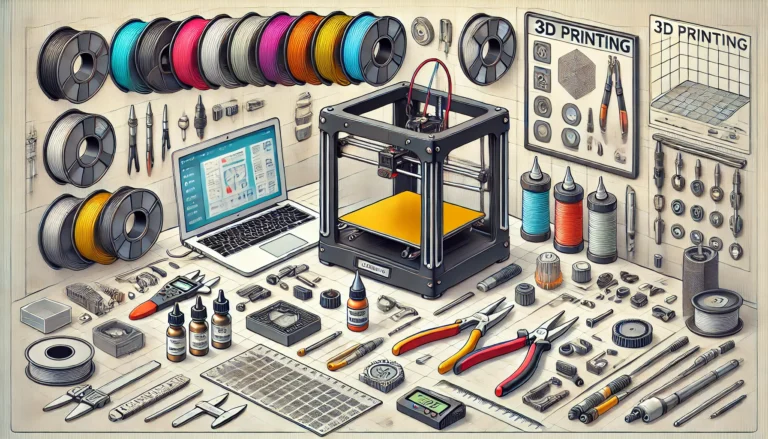3D Printer Safety Tips: What You Should Always Follow
Introduction
Welcome to the fascinating world of 3D printing! Imagine a device that can bring your wildest ideas to life, layer by layer, right before your eyes. It's like having a tiny factory on your desk, ready to produce everything from intricate models to useful household items. No wonder this technology is becoming a hot favorite among hobbyists, educators, and professionals alike. It's like magic, but with a dash of science!
But hold your horses before you dive headfirst into this captivating world. With great power comes great responsibility—or in this case, with great printing comes the need for some serious safety measures. Just like you wouldn't drive a car without learning the rules of the road, you shouldn't start printing without understanding the basics of keeping yourself and your surroundings safe.
Think of this as your 3D printing safety briefing. We’re here to ensure that your journey into this creative universe is both thrilling and secure. After all, what's the fun in printing a masterpiece if you're not around to enjoy it, right? So let's put on our safety hats (figuratively speaking) and explore how to make your 3D printing experience as safe as it is innovative. Whether you're a beginner or a seasoned pro, these tips are your best friends. Ready to get started? Let's go!
Understanding the Basics of 3D Printer Safety
Alright, let's get down to brass tacks—why is safety such a big deal when it comes to 3D printing? Picture this: you're all set to print an epic model of a dragon, but suddenly, you realize that your workspace is a fire hazard, or worse, you're inhaling some nasty fumes. Not quite the fantasy you had in mind, right? That's why understanding 3D printer safety is crucial!
First off, let's talk about the risks. 3D printers can get hot—like, really hot. We're talking about nozzle temperatures reaching as high as 500 degrees Fahrenheit! Touching that by accident could lead to some serious burns. And then there's the electrical side of things. These machines run on electricity, and if you're not careful, you could end up overloading a circuit or dealing with a short. Not exactly the kind of sparks you want to see flying.
Now, let's chat about the air quality. Some 3D printing materials release fumes that aren’t exactly roses and sunshine. Breathing in these fumes over time could lead to respiratory issues. So, unless you fancy the idea of a cough that won't quit, it's worth paying attention to ventilation.
And let's not forget about the materials themselves. Filaments and resins might seem harmless, but they can be tricky. Some resins are toxic and need careful handling. You wouldn’t chug a mystery potion without reading the label first, right? Same goes for these materials.
So, what's the takeaway here? Safety isn't just a checklist; it's a mindset. Think of it as your invisible armor, protecting you from accidents and keeping the fun in your 3D printing adventures. Remember, a safe maker is a happy maker!
Essential 3D Printer Safety Tips
Alright, let’s get into the nitty-gritty of keeping your 3D printing adventures safe and sound. Think of this as your go-to guide for avoiding any "oops" moments that could turn your creative session into a potential hazard zone. Safety first, fun always!
Proper Setup and Ventilation
First things first: your 3D printer deserves a nice home. A stable, flat surface is a must to prevent any wobbles that could lead to printing mishaps. But don’t just plop it anywhere—location matters! You want a well-ventilated area. Why? Because some 3D printing materials release fumes that are about as friendly as a porcupine in a balloon factory. Trust me, you don’t want to be breathing those in. So, crack a window, use a fan, or better yet, set up in a space with good airflow to keep things fresh and fume-free.
Handling Materials Safely
Next up, let’s talk materials. Filaments and resins are the lifeblood of your 3D printer, but they need a little TLC. Handle them like you’re handling a newborn puppy—gently and with care. Store them in a dry, cool place to avoid any degradation. And when it comes to handling certain materials, gloves and masks can be your best friends. Ever tried getting resin on your hands? It’s like trying to wash off a sticky situation—literally!
Electrical Safety Precautions
Now, onto the electric side of things. Your printer is a hungry beast when it comes to power, so make sure it’s plugged into a suitable outlet. Check those electrical connections like you’re inspecting a mystery novel for clues. Avoid overloading circuits, because nobody wants an impromptu light show in their workspace. And hey, surge protectors are a smart investment—think of them as bodyguards for your printer against unexpected power spikes.
Fire Safety Measures
Speaking of unexpected, let’s chat about fire safety. 3D printers can get hot—like, really hot. So, keep anything flammable far, far away. It’s a good idea to have a fire extinguisher on standby, just in case. You know, better safe than sorry. If you want to go the extra mile, consider a smoke detector nearby. It’s like having a trusty sidekick that alerts you to any sneaky smoke signals.
Regular Maintenance and Inspection
Finally, let’s keep things running smoothly with regular maintenance. Give your printer a once-over now and then to catch any wear and tear before it becomes a bigger issue. Clean it up, check for loose screws, and make sure everything is in tip-top shape. It’s like taking your car for a tune-up—only without the oil change and hefty bill!
By following these tips, you’re setting yourself up for a safe and successful 3D printing journey. So, go ahead, create masterpieces, and let your imagination run wild—just do it safely!
Proper Setup and Ventilation
Alright, let's talk setup. Imagine your 3D printer as a mini-factory right in your home. You wouldn’t want to set up a factory in the middle of your living room, right? Well, maybe you would, but let's keep it practical. The spot where you place your 3D printer should be stable, spacious, and well-ventilated. You see, 3D printers, while magical, aren’t just about creating cool stuff. They can also emit some not-so-great fumes, especially if you're using certain materials like ABS plastic. These fumes can turn your cozy room into a not-so-pleasant space if you're not careful.
So, what's the solution? Ventilation, my friend. It's key! Think of it as the lungs of your printing space. A well-ventilated area helps keep those pesky fumes at bay. Open windows are great, but if you’re in a closed space, consider investing in a small fan or an air purifier to keep the air fresh and your lungs happy. And hey, if you're feeling fancy, there are even special enclosures for 3D printers that come with built-in ventilation systems.
Remember, a well-ventilated setup doesn’t just help you breathe easy; it also keeps your 3D prints looking sharp and your printer running smoothly. Plus, it’s a great excuse to declutter and make space for your next big project. So, get that setup right, and you’ll be printing like a pro in no time!
Handling Materials Safely
Alright, let's dive into the nitty-gritty of handling those oh-so-important 3D printing materials. Whether you're working with filaments or resins, safety should always be your trusty sidekick. Think of it as your superhero cape—without it, you're just a person with a cool gadget!
First things first, let’s talk about storage. Ever heard the saying "out of sight, out of mind"? Well, that doesn’t apply here! You want to store your materials properly so they’re not just hanging around, waiting to cause trouble. Filaments should be kept in a cool, dry place to prevent them from becoming brittle or absorbing moisture like a sponge on a rainy day. Resins, on the other hand, are a bit more high-maintenance. They need to be stored in a dark, cool environment, away from sunlight, which can degrade them faster than you can say "oops."
Now, onto the hands-on part—literally. When you're handling these materials, think of yourself as a scientist in a lab. Gloves and masks are your best friends here. Why? Because some of these materials can be a bit sneaky. They might seem harmless, but they can irritate your skin or lungs if you're not careful. Nitrile gloves are great for keeping your skin safe from resins, while a mask can help you avoid breathing in any pesky particles or fumes. Trust me, your future self will thank you for this little extra effort.
And hey, if you're ever unsure about a material, don't just wing it. Check the manufacturer's guidelines or Material Safety Data Sheets (MSDS) for any specific handling instructions. It’s like reading the instructions before assembling IKEA furniture—except this time, it’s about keeping your health intact, not just avoiding an extra screw or two.
So there you have it, folks! Handling 3D printing materials safely isn’t just about avoiding sticky fingers. It’s about ensuring your creative journey is smooth, safe, and enjoyable. Keep those gloves handy, store smartly, and print like the rockstar maker you are!
Electrical Safety Precautions
Alright, let's talk about electrical safety. I know, I know, it's not the most thrilling topic, but trust me, it’s super important! Imagine this: you’re all excited to print that cool new design you just downloaded, and then—zap!—you’ve got an electrical disaster on your hands. Not fun, right? So, let's make sure that doesn't happen by getting our electrical safety game on point.
First things first, always check your electrical connections. Think of it like checking your shoelaces before a big race. Make sure everything is snug and secure. Loose connections can be a sneaky source of trouble, leading to overheating or even short circuits. And we want your 3D printing experience to be smooth sailing, not a shocking surprise.
Now, let’s talk about circuits. You know how you sometimes try to fit too many things in your suitcase and it just won’t close? Well, overloading your circuits is kind of like that, but with a lot more sparks. Avoid plugging your 3D printer into a power strip that’s already hosting your entire entertainment system. Instead, give it some breathing room by using a dedicated outlet.
And here’s a pro tip: invest in a surge protector. Think of it as a guardian angel for your printer, shielding it from those pesky power surges that can fry its delicate insides. They’re pretty affordable and can save you a ton of heartache (and money) in the long run.
Remember, a little caution goes a long way. Treat your 3D printer like you would a prized possession—because it is! By following these electrical safety tips, you can focus on bringing your creative visions to life without any shocking interruptions. Stay safe and happy printing!
Fire Safety Measures
Alright, let's talk about something that might sound a bit scary but is super important: fire safety. Now, I know what you're thinking—"Fire? From a 3D printer?" Yep, it's a possibility, but don't worry! With a few precautions, you can keep those flames at bay.
First off, let's get one thing straight: 3D printers can get hot. Like, really hot. We're talking about temperatures that can melt plastic, which is basically what they're designed to do. But this also means there's a risk of things going south if we're not careful. One of the main culprits of fire hazards is faulty wiring or poor-quality components. So, a good start is to ensure your printer is in tip-top shape and all the electrical connections are solid. Think of it as giving your printer a little check-up—better safe than sorry, right?
Now, let's talk about location, location, location. Make sure your 3D printer isn't surrounded by flammable materials like paper, fabric, or those mysterious piles of stuff we all have in our rooms. Give it some breathing room, like a spacious corner on a stable surface. And hey, it's not just about aesthetics—this helps prevent any accidental fires from spreading.
And here's a pro tip: always keep a fire extinguisher handy. It's like having a superhero sidekick ready to swoop in and save the day if things get a little too heated. Just make sure you know how to use it! You don't want to be fumbling around in an emergency.
Finally, consider using a smoke detector nearby. It can give you that early warning if something's amiss. It's like having a tiny, vigilant guardian watching over your printing escapades.
Remember, we're not trying to scare you away from 3D printing—it's all about being prepared. With these fire safety measures in place, you can focus on the fun part: creating awesome things without the worry. Happy (and safe) printing!
Regular Maintenance and Inspection
Alright, let's talk about something that might not sound as thrilling as watching your latest creation come to life, but trust me, it's just as important: regular maintenance and inspection of your 3D printer. Think of it like taking your car in for a tune-up, but without the dealership coffee that's somehow always lukewarm. Keeping your 3D printer in tip-top shape ensures that your prints come out as expected and that you're not inadvertently creating a fire hazard in your living room.
First things first, let's chat about cleaning. I know, I know, cleaning isn't anyone's favorite chore, but when it comes to 3D printing, a little elbow grease can go a long way. Dust and debris can wreak havoc on your printer's performance. So, grab a soft cloth and some isopropyl alcohol and give your printer a gentle wipe down. Pay special attention to the print bed and nozzles because that's where the magic—and sometimes the mess—happens.
Next up, let's inspect for wear and tear. Over time, certain parts of your printer, like belts and bearings, might start to show signs of wear. It's kind of like when your favorite sneakers start to look a little rough around the edges. Regularly check these components and replace them if needed. It's much better to swap out a belt than to deal with a print that looks like it melted in the sun.
And don't forget about firmware updates! Just like your smartphone, your 3D printer's software might need an update every now and then. Manufacturers often release updates to improve performance or fix bugs. It's like giving your printer a little boost of energy.
Finally, keep a log of your maintenance activities. It doesn’t have to be anything fancy—a simple notebook or a spreadsheet will do. Jot down when you last cleaned or replaced parts. Not only does this help you keep track of when the next check-up is due, but it also makes you look super organized. And who doesn't love the feeling of being on top of things?
Remember, a well-maintained printer is a happy printer. And a happy printer means more awesome creations for you! So roll up your sleeves, give your printer some TLC, and keep those prints coming out flawless. Your future self—and your projects—will thank you!
Personal Protective Equipment (PPE)
Alright, let's talk about the unsung heroes of 3D printing—Personal Protective Equipment, or PPE for short. Think of them as your trusty sidekicks in this exciting printing adventure. First up, we have safety goggles. These bad boys are essential because, let's face it, we don’t want any rogue plastic bits flying into our eyes. It's like wearing sunglasses, but for a much cooler reason!
Next, gloves. Not just any gloves, but ones that can handle the heat! 3D printing can get pretty toasty, and handling hot tools or freshly printed items can leave you with some unwanted burns. So, slip on those gloves like a pro. They're your best defense against heat and any sticky resin that might try to hitch a ride on your skin.
Masks are another piece of gear you might want to consider, especially if you're working with resins or certain filaments that can release fumes. You don't want to be inhaling anything nasty while you're lost in the moment of printing your masterpiece. So, a simple mask can help keep the air around you as fresh as possible.
Now, you might be thinking, "Do I really need all this gear?" Well, think of it this way: PPE is like the seatbelt of 3D printing. You might not always think you need it, but when things go awry, you'll be glad you wore it. Plus, there's something undeniably cool about gearing up like you're about to embark on a space mission, right?
Remember, folks, safety isn't just about following rules—it's about being smart and proactive. So, embrace your inner safety superhero, don that PPE, and print away with peace of mind. Your future self will thank you!
Alright, let's talk about the grand finale of your 3D printing adventure: post-processing. You've got your masterpiece fresh off the printer, and it’s sitting there, looking all shiny and new. But hold on! Before you start celebrating, there’s an important step—post-processing. It’s like putting the cherry on top of your 3D creation. But, as with all things involving tools and heat, safety comes first!
First things first, let’s talk about removing those prints. It might seem like a simple task—just pop it off, right? Not exactly. Prints can sometimes be stubborn, sticking to the print bed like a toddler to a favorite toy. Use a spatula or a removal tool designed for 3D printing, and be gentle. Think of it as coaxing, not prying. And remember, some parts might still be hot, so wear heat-resistant gloves if needed. You don’t want to end up with a new blister as a souvenir!
Now, onto the fun stuff: smoothing, sanding, and maybe even a little painting. When it comes to sanding, patience is your best friend. Use fine-grit sandpaper and work your way up. It’s like giving your print a spa day—gentle and thorough. And if you’re using any chemicals for smoothing, like acetone for ABS, make sure you’re in a well-ventilated area. Fumes are no joke, and we’d like to keep the air in our lungs as fresh as possible, thank you very much.
Handling sharp tools is another area where you’ll want to keep your wits about you. Hobby knives and rotary tools are fantastic for trimming and detailing, but they can also be fantastic at giving you an unexpected slice. Always cut away from your body, and keep those fingers out of the danger zone. It’s not just about the print looking good; it’s about you staying in one piece!
And finally, if you're using a heat gun or any other tools that generate a lot of heat, be cautious. These tools can make your prints look amazing, but they can also cause burns faster than you can say "ouch." Keep a safe distance, use them in short bursts, and never leave them unattended.
In short, post-processing is where your creativity can really shine, but always remember: safety first. Treat your tools with respect, and they’ll help you create wonders without any unwanted accidents. Now, go forth and polish that print to perfection!
Encouraging a Safety-First Mindset
Alright, folks, let’s get real for a second. I know safety might not sound as exciting as watching your latest print come to life, but trust me, it’s the unsung hero of every successful 3D printing project. Think of a safety-first mindset as your trusty sidekick—always there to keep you out of trouble. So, how do you cultivate this mindset? It’s all about making safety a habit. Not the kind of habit you dread, like flossing, but one that becomes second nature, like grabbing your morning coffee.
First off, let’s talk about staying informed. The 3D printing world is like a tech roller coaster—always changing and evolving. That means there's always something new to learn, especially when it comes to safety. Make it a point to keep up with the latest safety guidelines and best practices. And hey, it’s not all about reading dry manuals—there are plenty of cool YouTube channels and online forums where you can pick up tips from fellow enthusiasts. Think of it as a community where everyone’s got each other’s back.
Next, let’s sprinkle in some humor and a dash of humility. We all make mistakes—it's part of the learning process. So, if you forget to wear your safety goggles once or twice, don’t beat yourself up. Learn from it, laugh it off, and move on. The key is to recognize these slip-ups and turn them into opportunities for improvement.
And here’s a pro tip: make safety a team sport. If you’re part of a makerspace or a club, encourage your fellow makers to adopt a safety-first mindset, too. Share your safety hacks and horror stories (because who doesn’t love a good story?) and learn from each other’s experiences.
Remember, a safety-first mindset isn’t about being paranoid—it’s about being prepared. So, the next time you’re about to hit ‘print’, take a moment to do a quick safety check. Your future self—and your perfectly printed masterpiece—will thank you!
Alright, let's wrap this up! We've journeyed through the essentials of 3D printer safety, and now it's time to bring it all together. Remember, 3D printing is like having a superpower – you’re literally creating something out of nothing! But even superheroes need to be cautious. We've chatted about setting up your printer in the right spot, ensuring proper ventilation, handling materials like a pro, and keeping an eye on those electrical connections to prevent any shocking surprises. We’ve also talked about the importance of having a fire extinguisher on hand, just in case things get a little too heated.
Don't forget about the gear – those gloves and goggles aren't just for show. They’re your first line of defense against burns and nasty fumes. And once your masterpiece is done printing, remember to handle sharp tools with care during post-processing. It's all about keeping those fingers safe and sound.
So, what’s the takeaway here? Safety isn’t just a checklist – it’s a mindset. By prioritizing safety, you’re ensuring that your 3D printing adventures are not only creative and fun but also free from unnecessary risks. Keep learning, stay curious, and always be on the lookout for new safety tips and tricks. Happy printing, and stay safe out there!
